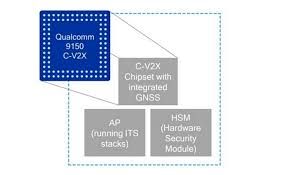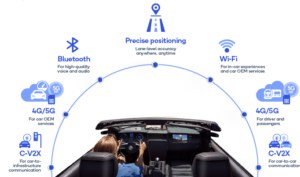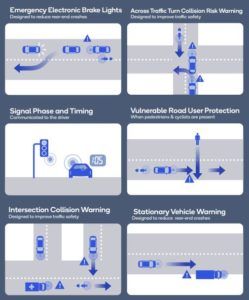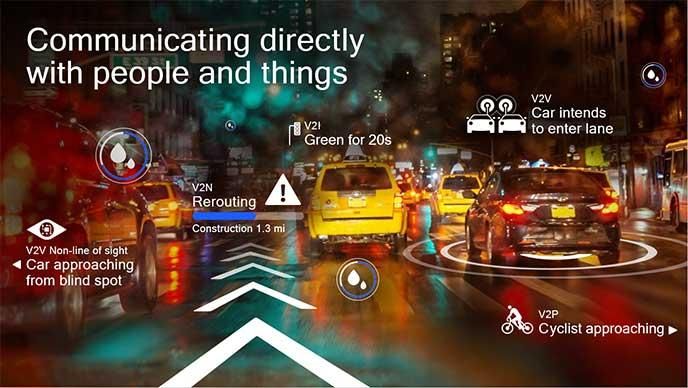At the Consumer Electronics Show (CES 2020) in Las Vegas, California-based semiconductor and telecommunications company Qualcomm Technologies has introduced a comprehensive new platform to accelerate the deployment of Cellular Vehicle-to-Everything (C-V2X) systems.
Building on the global momentum of C-V2X technologies, and to fulfil both the vehicular and the infrastructure needs to address secure road safety, and mobility applications, Qualcomm has introduced the new C-V2X reference platform for onboard (OBUs) and roadside units (RSUs). The Qualcomm C-V2X reference platform complements C-V2X communication solutions by offering computational power to deliver a full suite of 4G and 5G wireless, and C-V2X, solutions, including multi-frequency GNSS location services for precise positioning, V2X message security, signing and verifications and V2X Intelligent Transport System (ITS) stacks.
 The new C-V2X platform is based on the company’s high performance, low power architecture, and is optimised for use with software applications to further accelerate the deployment of C-V2X vehicular OBU systems and RSUs in the USA and globally. The new C-V2X platform’s main features and benefits include:
The new C-V2X platform is based on the company’s high performance, low power architecture, and is optimised for use with software applications to further accelerate the deployment of C-V2X vehicular OBU systems and RSUs in the USA and globally. The new C-V2X platform’s main features and benefits include:
- Snapdragon 2150 chipset, Qualcomm’s application processor engineered for smart infrastructure RSUs and OBUs for vehicles;
- Highly integrated V2X solution, which includes an application processor, ITS stack, Aerolink Security, message signing, up to 2,500 message verifications per second, PC5/Uu modem connectivity, Wi-Fi 6 and BT 5.1 connectivity, MF-GNSS, and controller area network (CAN) support;
- Clean architecture with modular, scalable and future-poof design;
- Supports secure domain isolation between C-V2X and telematics stacks and applications
- Supports V2X functionality, including ITS stacks, Aerolink V2X security solution with integrated message verifications and signing;
- Optimised communications with Snapdragon Automotive 4G and 5G Platforms with integrated C-V2X technology, including simultaneous WWAN Uu network communication and C-V2X side-link PC5 direct communications;
- Modem interface drivers and telematics/C-V2X software development kits for accelerated integration and apps/services development;
- Driver support for Linux BSP;
- Driver support for third-party hardware security modules.
C-V2X is globally compatible with 5G and complements other Advanced Driver Assistance Systems (ADAS) sensors, such as cameras, radar and lidar. C-V2X direct communication mode is designed to offer vehicles a low latency method to ‘talk’ directly with other vehicles, roadside infrastructure and pedestrians without the involvement of a cellular network or subscription, by operating in the designated and harmonized 5.9GHz ITS spectrum.
Recent field tests using Qualcomm’s solutions have shown significant range, reliability, and performance advantage of C-V2X direct communications, with more than twice the range and most importantly improved reliability compared to 802.11p radio technology. Qualcomm has worked with leading automotive, road operators, infrastructure and technology companies across the globe to demonstrate the benefits and maturity of C-V2X technology, including trials and demonstrations throughout the USA, Europe and Asia.
“We have prioritised development of comprehensive C-V2X on-board unit (OBU) automotive platforms as we help advance C-V2X for the connected car, and we are now extending these solutions to roadside infrastructure,” said Nakul Duggal, senior vice president of product management at Qualcomm. “Leveraging our C-V2X reference platform, we are able to offer solutions that offer C-V2X connectivity, 4G and 5G wireless connectivity with application processing that pre-integrates our Aerolink technology, our proprietary V2X security, as well as signing and stacks, making our industry-leading turnkey connected car, and RSU platforms, easy to develop and deploy rapidly.”





